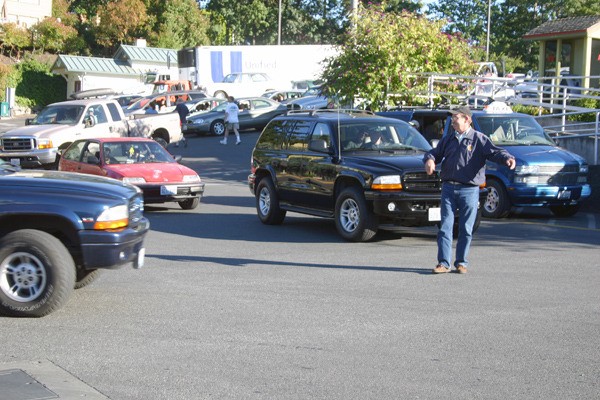Curb bulbs to improve pedestrians’ sight of traffic. Directional signage. And — dare we say it? — lights to control traffic when the ferry is offloading.
Those are some of the pedestrian and traffic control measures that could be funded by $230,000 earmarked for the Friday Harbor ferry terminal. The money is included in the federal transportation budget being considered by Congress.
“It has passed the full House Appropriations Committee,” said Emily Halnon, spokeswoman for Rep. Rick Larsen, D-Everett, who pushed for the funding’s inclusion in the budget.
“The bill the funding request is included in will most likely be considered on the House floor on Thursday.”
Washington State Ferries spokeswoman Marta Coursey said the money would be used for placement of four pedestrian bulbs at Spring and Front streets, a pedestrian barrier “to reduce pedestrian/vehicle conflicts,” and directional signage “near the 300 block of Spring Street.”
Pedestrian bulbs are also known as curb bulbs and curb extensions, and are used in several cities to improve the pedestrian’s view of traffic.
“[They] extend the sidewalk or curb line out into the parking lane, which reduces the effective street width,” the Seattle City Transportation Department website states. “Curb extensions significantly improve pedestrian crossings by reducing the pedestrian crossing distance, visually and physically narrowing the roadway, improving the ability of pedestrians and motorists to see each other, and reducing the time that pedestrians are in the street.”
The pedestrian barrier is designed to keep pedestrians from walking in front of vehicles as they offload from the ferry. Lights could be used to keep vehicles from turning onto Front Street when the ferry offloads.
“This investment will improve pedestrian safety and circulation, ferry loading and offloading efficiency, and schedule reliability at the ferry terminal,” Larsen’s office wrote in an announcement of the funding. “Pedestrians are currently crossing Front Street and Spring Street near the ferry terminal in an uncontrolled manner that creates conflicts with vehicle loading and offloading operations.”
Larsen said, “Washington state residents depend on the largest ferry system in the country to keep our economy moving. This investment will make the Friday Harbor Ferry Terminal safer and more efficient for both the folks who rely on the ferry to commute between home and work and for visitors who use the ferry system to tour our beautiful region.”
Local officials have long grappled with the problem of pedestrian and vehicle conflicts at the Friday Harbor ferry landing. The problem is compounded by the fact that the ferry offloads into a downtown area. And enforcement of pedestrian and vehicle controls on Front Street has been sporadic; Sheriff Bill Cumming happened to be on Front Street on Friday and stepped in to direct traffic when a car went the wrong way on Front Street, stopping vehicles from offloading from the 6:10 ferry. Pedestrians and vehicles cut in front of cars and trucks as they offloaded, further clogging the street.
County, port, town and WSF representatives met in 2006 to develop ways to improve the flow of pedestrians and vehicles during ferry offloads. The process was funded with $250,000 obtained by Transportation Commissioner Bob Distler, state Sen. Mary Margaret Haugen, and then-County Councilman Kevin Ranker. But when the planning was completed, WSF said it didn’t have any funding to implement the recommendations.
One idea proposed by Distler: An overhead walkway that would take pedestrians from the ferry to East Street, allowing pedestrians and vehicles to offload concomitantly.
The traffic circle at the end of Front Street, in front of the Friday Harbor Marina office, is the result of an earlier intermodal planning effort.



